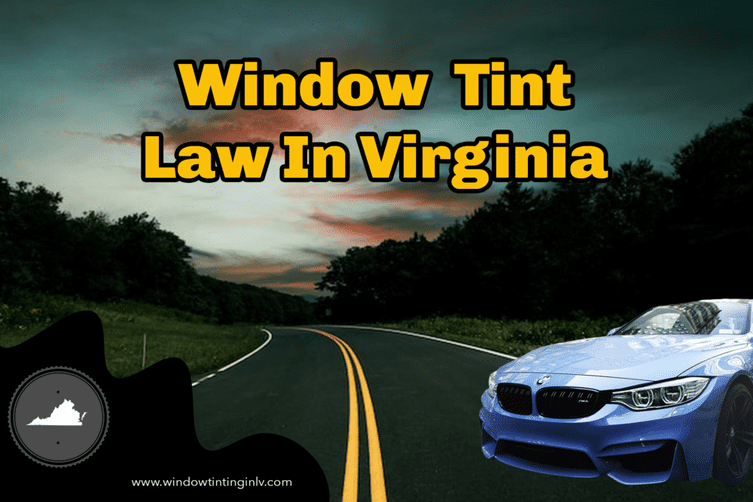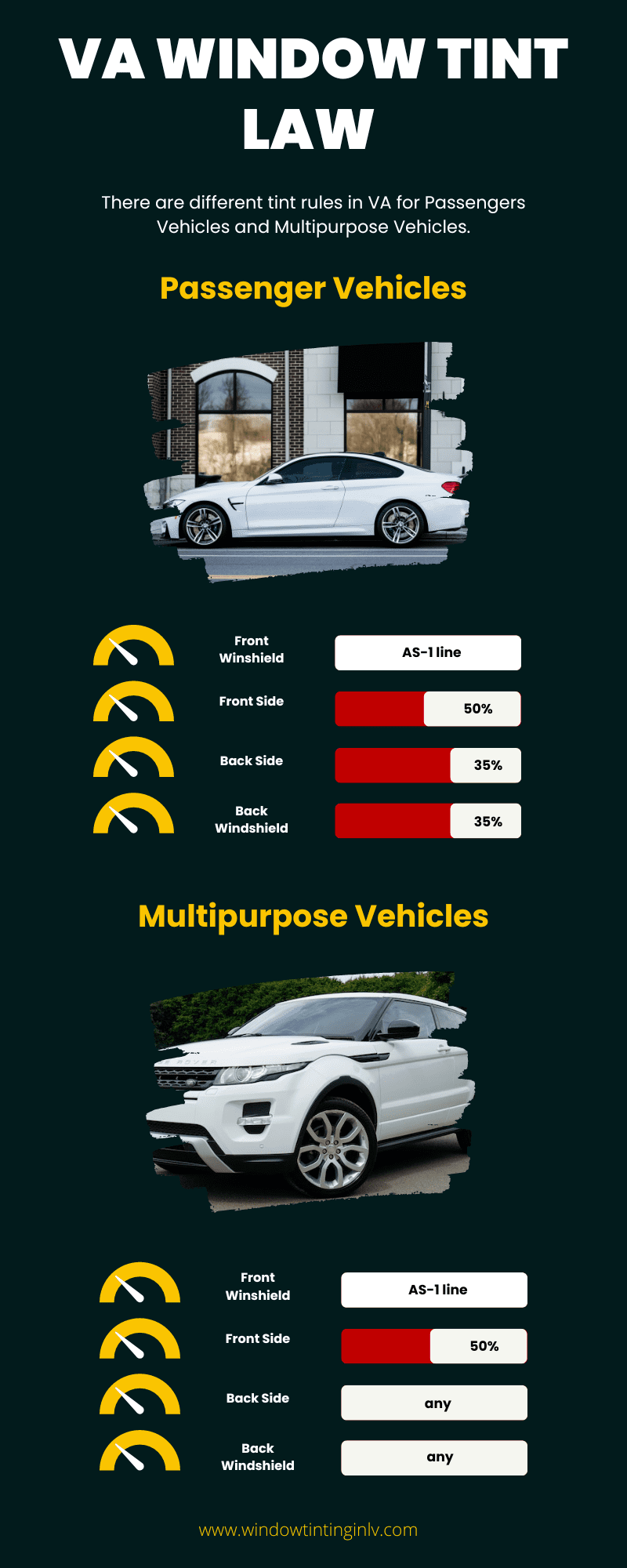
Disclaimer: As an Amazon Associate I earn from qualifying purchases.
Ever thought of getting your car windows tinted? We bet you must have thought about it at least once! Tinted windows look stunning and amplify your car’s appearance to a great extent. But do you know there is a certain window tint law in Virginia that you must follow?
Every state has its own set of car window tinting laws, rules, and regulations.
If you live in Virginia, here is what you should know about tinting laws. Back in the year 1999, Virginia being the 34th state of all 50 states, got its tinting laws.
This article has included all the legal information about the state tint laws you need to know to get your car windows tinted.
Visible Light Transmission [VLT] – Window Tint Law In Virginia
The amount of light or % that passes through the window is defined as VLT. The lower the percentage, the darker the tint will be.
For example, if you have opted for 5% VLT, this will allow only 5 percent of light to pass through the glass, making the glass appear darker.
Furthermore, the Virginia window tint law is different for Sedans, SUVs, and Vans. This VLT differs in all fifty states in the United States.

Window Tint Darkness for Sedans, SUVs, and Vans:
In Virginia, there is a predetermined dark tint percentage for tinting windows according to the vehicles you own.
So, if you plan on doing so, it is advised to keep the following in check!
VA Window Tint Law Darkness for Sedans or Passenger Vehicles:
- Windshield: The Virginia window tint law allows a non-reflective tint of 5 inches from the top or AS-1 Line
- Front side windows: They should permit 50% of light or more to pass through or 50% VLT
- Rear side windows: They should permit 35% of light or more to pass through or 35% VLT
- Rear window: It should permit 35% of light or more to pass through or 35% VLT
Virginia Window Tint Law Darkness for SUV and Vans:
- Windshield / Windscreen: Should have a non-reflective tint of 5 inches or AS-1 Line
- Front side windows: Should allow more than 50% of light to pass through or 50% VLT
- Backside windows: There is no such limitation for backside windows; you can use any darkness
- Rear window: There is no such limitation for backside windows; you can use any darkness
Window Tint Reflections for Sedans, SUVs, and Vans:
Window tints reflect light and can greatly reduce heat and glare. In Virginia, there is a law also for window tint reflection. They have determined the level of reflection according to vehicle type.
So, if you wish to tint your car windows, keep this in check.
Window Tint Reflections for Sedans or Passenger Vehicles:
- Front Side Windows: Should allow less than 20% reflection
- Backside Windows: Should allow less than 20% reflection
Window Tint Reflections for SUVs and Vans:
- Front Side Windows: The optimum percentage for reflection is limited to 20%
- Backside Windows: The optimum percentage for reflection is limited to 20%
Medical Exemptions: Virginia Window Tint Laws
If you or your family need sun shading, you can check for medical exemptions.
This is quite a time-consuming process.
Suppose you look forward to applying for medical authorization. In that case, the individual must submit a fully completed Sun-Shading Medical Authorization Application to the Department of Motor Vehicles DMV.
The application you or anyone in your family submits must include the vehicle’s information and a statement from the doctor, doctor’s assistant, nurse, optometrist, or ophthalmologist to certify that sun shading is necessary for the person’s health.
Then, the vehicle’s owner will get a new registration card. This card has ‘sun shading’ printed under the space of Special Conditions.
This newly registered card will be a verified source for your vehicle’s authorization for sun shading.
After having a medical exemption, you will be allowed to have your front windows tinted to 35% VLT. You will be allowed to tint your windscreen or windshield to 70% VLT.
Not just this, you can also tint the AS-1 Line or the top 5 inches of your windscreen to 35% VLT.
Want to look at the medical exemptions for tint laws in all the states of the country? Click here.
Legal Tint Virginia | Other Window Tint Rules and Regulations:
If you live in Virginia, you need to know that there are other significant rules, regulations, and laws when it comes to tinting your vehicle’s windows.
And if you are a bit more conscious of how your car appears, then you better check the following:
Side Mirrors: If any of your windows are tinted, side mirrors are required!
Tinting Variance: Regarding tint variance, 7% of the variance is acceptable.
Restricted Shades: There will be a pool of tint film shades to choose from, but in Virginia, some shades like yellow, red, and amber window tints are restricted.
Stickers: Yes, you can apply stickers, but they have to be unspecified.
Window Tint Certification Rules: There is no need for the manufacturers to certify that they sell films in the state.
Medical Exemptions: Virginia Window Tint Laws allow medical exemptions if you wish to use a special tint.
Penalties: You will be penalized under Class 2 misdemeanor for subsequent offenses and Class 3 misdemeanor for a first offense.
Frequently Asked Questions: Virginia Tint Laws
Is 5 tint illegal in Virginia?
No, a 5% tint is not illegal in Virginia. You can apply a 5% tint only if you own a van or an SUV. Not just this, the 5% tint is only for your vehicle’s back and rear windows.
What is the darkest legal tint limit in Virginia?
The Virginia state law states, that if you own a multi-purpose vehicle, you can apply any tint percentage, and that too on certain windows.
If you wish to tint your car windows, follow this:
The front side windows must allow at least 50% of light to pass through, the back side windows should allow 35% of light to get in, and the rear window should also allow 35% of light to pass in.
The windshield can be tinted as an AS-1 line.
Is tinting vehicle windows illegal in Virginia?
No, certainly not! According to the Virginia state laws of tinting, this depends on the vehicle you own. They have variant rules and regulations for sedans and multi-purpose vehicles such as Vans and SUVs.
Conclusion For Window Tint Law in Virginia
Window tint law in Virginia has classified vehicles and determined vehicle-specific tinting rules.
But, what we would add is that the law in this state can change or can be interpreted differently where you live. So, it would be best if you cross-check the above information with your Law Enforcement Authorities [LEA] or local DMV.
References:
Vehicle Sun-Shading Medical Authorization in Virginia
State Window Tinting Rules & Laws
https://law.lis.virginia.gov/vacode/title46.2/chapter10/section46.2-1052/
Check Out Other States Window Tint Laws:
Window Tint Law In California
Texas Window Tint Laws
Nevada Window tinting Laws
Window Tint Laws in Florida
Window Tint Laws in Ohio
North Carolina Window Tint Laws
Pennsylvania Tint Laws
Window Tint Law In Illinois
Window tint Law In Georgia
Michigan Window tint Laws